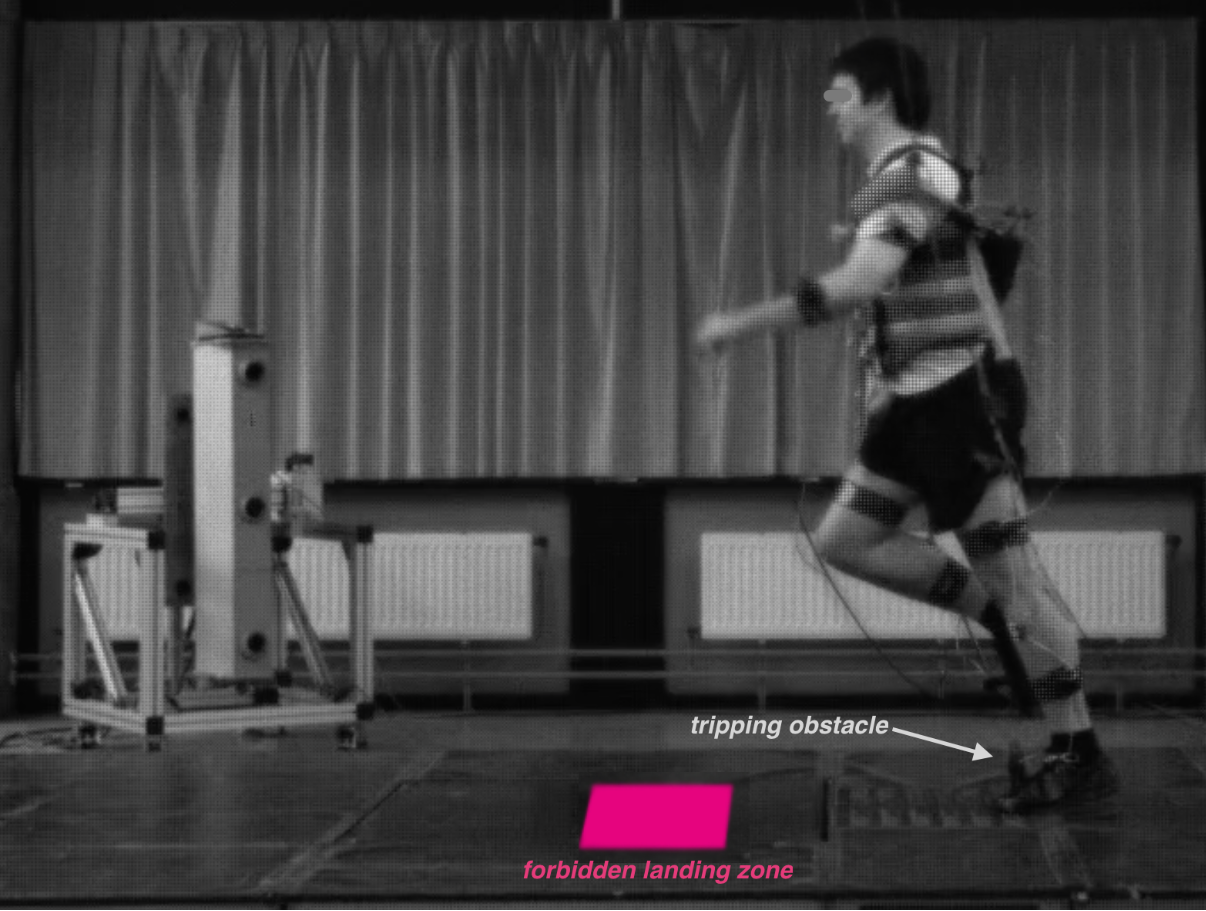Falls in the ageing population are a major societal problem, due to their adverse effects on health and quality of life. A large proportion of falls occurs due to tripping, but not all trips end in falls. Following a trip, we can regain balance by moving our trunk and rapidly pushing off with the un-tripped leg to take a recovery step with the tripped leg. Taking an appropriate recovery step is especially important in older adults (especially fallers), who often take recovery steps that are too short to prevent falling following a trip. Hence, in theory, adjusting their trip recovery steps might reduce the number of falls. Still, when you are tripping, you are most likely not aware of your reaction, let alone of how to adjust it. Therefore, the main question of our research was whether it is even possible to adjust a trip recovery step?
Because young adults would most likely be best at adjusting their trip recovery responses, we asked 16 healthy young adults to walk numerous times over a specific path. On some of the walking trials, we unexpectedly tripped them by suddenly releasing an obstacle from the floor. In order to enforce adjustments of trip responses, some of the trips included a ‘forbidden landing zone’, which appeared at trip onset in each participant’s preferred recovery step landing position (see Figure). Participants had to avoid these forbidden zones by adjusting their responses and stepping elsewhere. Our results showed that trip recovery responses could be adjusted and the forbidden zone was successfully avoided in 80% of trials by step shortening or stepping to its side. Participants became significantly better over trials and even those initially failing to avoid the forbidden zone were eventually able to avoid it. Additionally, after experiencing trials in which the forbidden zone appeared, participants also modified their ‘normal’ tripping recovery responses, towards a response resembling ‘adjusted’ tripping.
Our results suggest that young adults are able to learn a new way of responding to trips in general, which is very promising for our ultimate aim of improving dangerous and inadequate trip recovery responses in older adults. However, it remains to be seen whether older people are also able to adjust their trip responses and, if they are, whether learning to take different recovery steps would reduce the number of falls caused by tripping in daily life situations.

Figure: Photo of a tripping trial in which a forbidden foot landing zone (highlighted in pink) was shown, forcing a trip recovery step adjustment.
Publication
Potocanac Z, de Bruin J, van der Veen S, et al (2014) Fast online corrections of tripping responses. Exp Brain Res 232:3579–90. doi: 10.1007/s00221-014-4038-2
http://link.springer.com/article/10.1007%2Fs00221-014-4038-2
About the Author

Zrinka Potocanac
Department for automation, biocybernetics and robotics of Jozef Stefan Institute, Ljubljana, Slovenia
Zrinka Potocanac is a Postdoctoral associate at the Department for automation, biocybernetics and robotics of Jozef Stefan Institute in Ljubljana, Slovenia. The study presented here was part of her doctoral work performed within the MOVE-AGE program at the Department of Kinesiology, Faculty of Kinesiology and Rehabilitation Sciences, KU Leuven and MOVE Research Institute Amsterdam, Faculty of Human Movement Sciences, VU University Amsterdam.
Zrinka’s research aims to understand biomechanical and neural control mechanisms underlying gait and balance recovery and our ability to quickly adjust these in face of changing environments.
Copyright
© 2018 by the author. Except as otherwise noted, the ISPGR blog, including its text and figures, is licensed under a Creative Commons Attribution-ShareAlike 4.0 International License. To view a copy of this license, visit https://creativecommons.org/licenses/by-sa/4.0/legalcode.
ISPGR blog (ISSN 2561-4703)
Are you interested in writing a blog post for the ISPGR website? If so, please email the ISGPR Secretariat with the following information:
- First and Last Name
- Institution/Affiliation
- Paper you will be referencing
